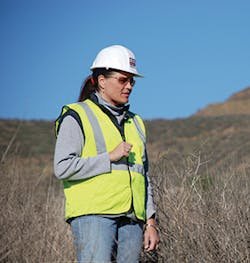Jennifer Hildebrand, CPESC, CPSWQ, CESSWI, ToR, QSD, and QSP, is the environmental compliance group manager for WSB & Associates in St. Paul, MN. She didn’t set out in life to go into the industry, but today, she is one of its shining stars.
Her B.S. and M.B.A. degrees in business management from Cardinal Stritch University and Augsburg College, enable her to examine environmental problems “through the lens of profitability, as opposed to always looking at the compliance arena of water quality or environmental benefit,” she notes. “Although that’s equally important, as specialists in this business, we should speak in terms the construction or manufacturing community can relate to: that making decisions on projects to maintain environmental compliance can not only minimize a project’s risk, but ultimately increase a project’s profitability.”
WSB is a consulting and design firm providing engineering, planning, environmental, and construction services to clients in the government, energy, and commercial markets. The projects vary, but the goal remains consistent: “Follow the rules and you will stay out of trouble,” says Hildebrand. “Often, business clients want you to bend the rules for them. I remind them if we begin that process, it is difficult to know where to stop. Ultimately, a client will value what you do for them and understand that the long process of following environmental compliance rules is a much more solid decision.”
Still, she says, “We compliance specialists have to admit these regulations are very complicated. The best success in training and outreach is when I am able to understand the challenges from their perspective.”
Hildebrand has served as International Erosion Control Association’s professional development committee chair, administrative vice chair for the CPESC and CPSWQ boards, vice president for IECA’s Northern Plains Chapter, and treasurer for the Minnesota Erosion Control Association. She was one of the first educators to build an IECA web-based learning chronicle for membership outreach and training. She’s also the author of a Forester Media publication, Straight Talk: Strategies for Environmental Compliance.
What She Does Day to Day
Hildebrand’s daily activities are driven by clients’ needs in terms of stormwater pollution prevent plans (SWPPPs) and NPDES permits for construction, municipal separate storm sewer systems, and industrial sites. Current projects include the St. Croix Crossing project, an extradosed bridge construction project connecting Minnesota and Wisconsin over a federally designated wild and scenic river involving more than 19 regulatory agencies and other industry groups with environmental compliance requirements. Hildebrand’s team is also working on a construction manager and general contractor project in Virginia, MN, where the transportation department is working with Kiewit Infrastructure Co. to build the state’s highest bridge over an abandoned mine pit converted into a lake. The Rochelau Pit has very high environmental sensitivity as the town’s drinking water source and host of several aquatic species.
What Led Her Into This Line of Work
Hildebrand initially wanted to be an accountant, but says that after graduating, she just wanted a job. Working summers with a grading contractor who distributed erosion control products planted the seed, which sprouted in the early 1990s when she started working with environmental regulations. When the company for which she worked mistakenly filled in a wetland, her boss told her, “Get us out of this trouble.” She’s been helping public and private entities stay in environmental compliance ever since. “There are few industries where I could do something good—which in my opinion this industry does—and still have the opportunity to make a profit,” she says.
What She Likes Best About Her Work
“I like what I do because it oftentimes leads to innovation and creativity in a solution that doesn’t exist,” says Hildebrand. “That drives someone who has a creative tendency, a need to provide innovation or create something for a solution.”
Her Biggest Challenge
Managing clients’ problems on a construction site, in an MS4 community, or for an industrial facility is Hildebrand’s biggest challenge. “Instead of shoving the problem aside, I have found the best success is running to the problem and working with that client, developing a tolerance for a solution that the client can live with long term,” she says. “We stare it square in the face and figure out how we can best determine a solution that works for both the regulatory environment and that client’s needs.”


